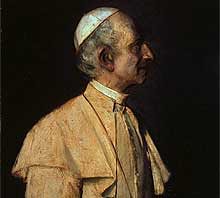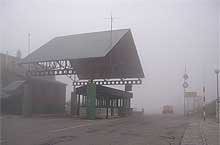A reader has kindly directed us to James Carroll's latest thoughtful appreciation of Catholicism. After explaining that a literalist understanding of the Crucifixion really has very little to do with Christianity:
In the first centuries of the church, the bloody crucifixion had little hold on the religious imagination of Christians. Scratched on the walls of the ancient catacombs, for example, one finds drawings of the communion cup, the loaf of bread, the fish -- but rarely if ever the cross.Mr. Carroll shows us how medieval Papism perverted the faith into a morbid obsession:
Early Christians revered the death of Jesus, of course, but they evoked it metaphorically, not literally, more with the image of going down into the waters of baptism than with nails and blood.
It was only in the medieval period that the Latin church began to put the violent death of Jesus at the center of faith, but that theology was tied to a broader cultural obsession with death related to plagues, millennialism, and the carnage of the Crusades. Grotesquely literal renditions of the crucifixion came into art only as self-flagellation and other "mortifications" came into devotion. Good Friday began to replace Easter as the high point of the liturgical year. And God came to be understood as so cruel as to will his son's agonizing death as the only way to "atone" for the sins of fallen humanity.The vital part of Mr. Carroll's musings, of course, isn't his gladness for a renewed appreciation of the Resurrection. It is his condemnation of Romanism as a perverse religion which, like Hustler magazine, appeals to a "prurient" taste for agony and death and turns its back on a delightful Gospel message full of truth, love, and life wrapped in unsearchable mysteries which forbid Catholicism's dark and bloody fascination with the death of Christ. In other words, Mr. Carroll has read Frederica Mathewes-Greene and recalled the old saw that "good artists borrow, but great artists steal."
Mr. Carroll would no doubt diagnose it as Papist sadomasochism, and Ms. Matthewes-Greene as an example of Romish theological compulsion, but it is nonetheless true that God has ordered the universe in such a way that the Catholic Church must always be repugnant to some. Catholics err when they think that divine law sets uniform limits on the character, extent, or duration of that repugnance. The new springtime of evangelization may not begin this year, or this century. I will even be so bold as to point out that while Leo XIII had a vision in which our Lord granted Satan 100 years for a Job-like attempt to destroy the Church, our Lord did not say when that 100 years would begin.
Likewise, we also err by imagining a divine law that limits dislike of Catholicism to only brutal, stupid, and illiterate people who wish for evil to befall us. Catholicism can be disliked in alleyways and gutters, but it can also be disliked in nice suburban homes and in the polite, educated world of the literati. When the Papists dwell on the bloody, agonizing, and terrible death of Jesus with love, it is understandable that people who do not like Papism very much will find this to be just another sign of Papism's unendurable nature.
The hallmark of men who find Catholicism repugnant is not their time, their state in life, or even the merits of their opinions. It is in their arrogance. An arrogance which, in this case, has assumed that something icky and nasty confirms their repugnance, and that it doesn't call on them to wonder whether the nastiness belongs to them and not to what they dislike. Papism says that the bleeding face of the Lord, his torn flesh and lifeless corpse, are beautiful. They are beautiful because they are a divinely-willed token of an infinite regard which makes Mr. Carroll's love of life, and Ms. Matthewes-Greene's wondrous awe at the resurrecting forgiveness of sins, possible.
Few opinions are rendered without some truth, however badly understood. In their dislike of Papism's adoration of the Crucifixion, Mr. Caroll and Ms. Matthewes-Greene might have hit on something worth thinking about. The world of Christ is vast. Mr. Carroll is right to search in it for all the answers to the great questions of truth, peace, and justice. Ms. Matthewes-Greene is also right to embark on her pilgrimage through all the mysterious and joyous perfections so beautifully contained in the hymns and prayers of the East.
Compared to that, one can see how Romanist devotion to the spectacle of a God-Man bleeding in the furious agony of His Crucifixion might be thought of as a rather crude and lowly activity for Christians whose world contains so much more than cut flesh, ragged breathing, and tortured limbs. Everyone can talk about how beautiful a tree is, but few people spend a good deal of time praising the exquisite color, contour, and power of the seed. But surely even Mr. Carroll and Ms. Matthewes-Green will admit that the Crucifixion is there, in the world of Christ. That fact might allow for a moderation of their hauteur.
Perhaps an ecumenical spirit could move Ms. Matthewes-Greene, as noblesse oblige could move Mr. Carroll, to try thinking of Papists who fixate on the Crucifixion as they might by analogy think of janitors, hospital orderlies, or nursing-home attendants -- people who are devoted to doing distasteful things, but who are useful nonetheless for the assistance they render to life's really important matters. That would, at least, be an improvement.











No comments:
Post a Comment